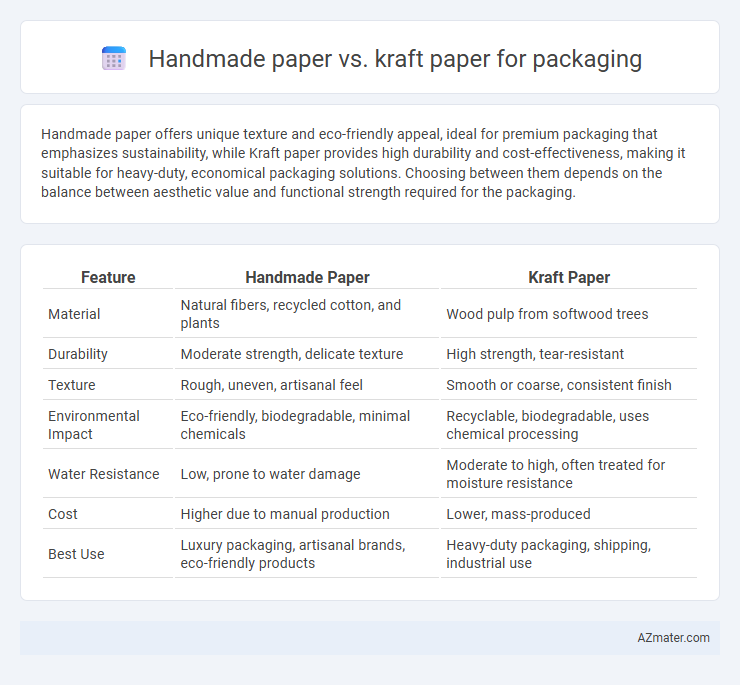Handmade paper offers unique texture and eco-friendly appeal, ideal for premium packaging that emphasizes sustainability, while Kraft paper provides high durability and cost-effectiveness, making it suitable for heavy-duty, economical packaging solutions. Choosing between them depends on the balance between aesthetic value and functional strength required for the packaging.
Table of Comparison
| Feature | Handmade Paper | Kraft Paper |
|---|---|---|
| Material | Natural fibers, recycled cotton, and plants | Wood pulp from softwood trees |
| Durability | Moderate strength, delicate texture | High strength, tear-resistant |
| Texture | Rough, uneven, artisanal feel | Smooth or coarse, consistent finish |
| Environmental Impact | Eco-friendly, biodegradable, minimal chemicals | Recyclable, biodegradable, uses chemical processing |
| Water Resistance | Low, prone to water damage | Moderate to high, often treated for moisture resistance |
| Cost | Higher due to manual production | Lower, mass-produced |
| Best Use | Luxury packaging, artisanal brands, eco-friendly products | Heavy-duty packaging, shipping, industrial use |
Introduction to Handmade Paper and Kraft Paper
Handmade paper is crafted using traditional techniques involving natural fibers, typically from cotton, linen, or recycled materials, resulting in a textured, eco-friendly product favored for artisanal packaging. Kraft paper, derived from wood pulp through the kraft process, offers high tensile strength and durability, making it a preferred choice for heavy-duty packaging and industrial applications. Both materials provide sustainable options, but handmade paper emphasizes aesthetics and uniqueness, while kraft paper focuses on robustness and cost-efficiency.
Composition and Manufacturing Process
Handmade paper is crafted from natural fibers like cotton or recycled rags, using traditional molding and pressing techniques that create a textured, eco-friendly material. Kraft paper is produced from wood pulp through the kraft chemical pulping process, resulting in a strong, coarse, and brown paper ideal for industrial packaging. The manufacturing of handmade paper is labor-intensive and sustainable, whereas kraft paper is mass-produced for durability and cost-efficiency in packaging applications.
Environmental Impact and Sustainability
Handmade paper demonstrates superior environmental impact due to its use of recycled fibers, non-toxic processing, and biodegradability, making it a sustainable packaging choice with minimal carbon footprint. Kraft paper, produced from wood pulp via the kraft process, offers high durability and recyclability but involves chemical treatments that can increase environmental load unless sourced from certified sustainable forests. Choosing handmade paper supports low-energy production and waste reduction, whereas kraft paper emphasizes strength and recyclability, both contributing uniquely to eco-friendly packaging solutions.
Strength and Durability Comparison
Handmade paper exhibits unique fiber interlocking that enhances its tensile strength, making it suitable for lightweight packaging requiring aesthetic appeal. Kraft paper, produced through the chemical pulping process, offers superior durability and resistance to tearing, ideal for heavy-duty packaging and shipping applications. The high lignin content in Kraft paper contributes to its robust structure, outperforming handmade paper in long-term strength and moisture resistance.
Aesthetic Appeal and Customization Options
Handmade paper offers a unique aesthetic appeal with its textured surface and natural fibers, making it ideal for luxury packaging and artistic branding. Kraft paper provides a rustic, earthy look with high durability, favored for eco-friendly and minimalist packaging designs. Customization options for handmade paper include embossed patterns and natural dyeing, whereas kraft paper allows for easy printing, stamping, and coating for enhanced functionality.
Cost Analysis for Packaging Solutions
Handmade paper typically incurs higher production costs due to labor-intensive processes and limited scalability, making it less economical for large-scale packaging needs. Kraft paper offers a cost-effective alternative with mass production capabilities, lower raw material expenses, and greater durability, which reduces replacement and damage costs. Businesses seeking affordable packaging solutions often prefer kraft paper for balancing cost efficiency and environmental sustainability.
Biodegradability and Recycling Potential
Handmade paper, crafted from natural fibers like cotton or hemp, offers superior biodegradability, breaking down quickly and enriching soil without harmful residues. Kraft paper, produced from wood pulp, is also biodegradable but degrades more slowly due to its dense fiber structure, though it excels in durability for heavy-duty packaging. Both papers are highly recyclable; however, handmade paper's lower chemical treatment enhances its recyclability and reduces environmental impact compared to Kraft paper.
Applications in Packaging Industries
Handmade paper, known for its durability, texture, and eco-friendly properties, is widely used in luxury packaging, gift wrapping, and artisanal product presentations, enhancing brand value with its unique, natural aesthetics. Kraft paper excels in industrial packaging due to its high tensile strength, tear resistance, and cost-effectiveness, making it ideal for shipping boxes, grocery bags, and protective wraps in mass production. Packaging industries often choose handmade paper for premium, sustainable packaging solutions, while kraft paper dominates in bulk packaging, balancing performance and affordability.
Consumer Perception and Brand Image
Handmade paper packaging conveys a premium, eco-conscious image that resonates with consumers seeking sustainability and artisanal quality, enhancing brand authenticity. Kraft paper packaging is perceived as durable, natural, and cost-effective, appealing to consumers valuing practicality and environmental responsibility. Brands using handmade paper often attract niche markets focused on luxury and differentiation, while kraft paper supports mass-market appeal with an emphasis on recyclability and robustness.
Choosing the Right Paper for Your Packaging Needs
Handmade paper offers a unique, eco-friendly texture ideal for luxury or artisanal packaging, providing a natural and breathable quality that enhances product presentation. Kraft paper, known for its durability and tear resistance, is perfect for heavy-duty packaging, shipping, and products requiring robust protection. Selecting the right paper depends on balancing aesthetic appeal with functional strength based on the specific packaging requirements and environmental considerations.

Infographic: Handmade paper vs Kraft paper for Packaging
 azmater.com
azmater.com